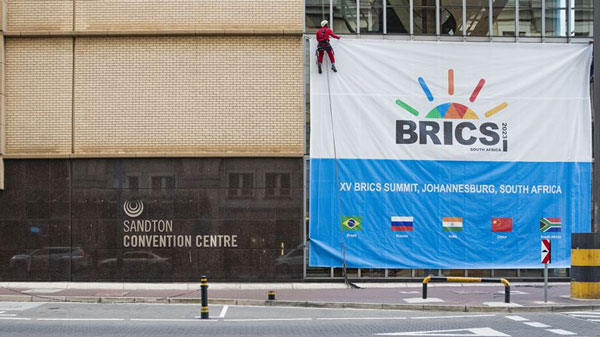
Even if doesn’t sound the death knell of the current order, it highlights widely shared grievances against it
COMMENT | ANA PALACIO | The just-concluded BRICS summit bringing together the leaders of Brazil, Russia, India, China, and South Africa was touted as a pivotal event that could change the contours of international relations. Some compared it to the Bandung conference of 1955, which laid the foundation for the Non-Aligned Movement, while others anticipated movement toward an alternate system of global governance fit for a multipolar world. But what the summit showed is that shared grievances do not amount to a shared vision.
The bloc’s decision to admit six new members Argentina, Egypt, Ethiopia, Iran, Saudi Arabia, and the United Arab Emirates – may seem to vindicate predictions that the BRICS will remake the world order. After all, more than 40 countries were allegedly vying for membership, though a formal list was never disclosed.
But the decision to expand like the push for de-dollarisation amounts to picking low-hanging fruit. When it comes to the numerous thorny global challenges requiring urgent attention, the summit provided little in the way of solutions. And that can be expected to continue: ultimately, the BRICS has always been more statement than substance, with each member using it as a platform to advance its own ends. A larger, even more heterogeneous membership will impede consensus on all matters of consequence.
Start with South Africa, the summit’s host. Not only was the country excluded from the G7 summit earlier this year; it has also faced criticism for its supposedly neutral stance on the Ukraine war, and the United States has accused it of providing weapons and ammunition to Russia. In a recent speech, South African President Cyril Ramaphosa noted that “some of our detractors prefer overt support for their political and ideological choices,” and vowed not to be “drawn into a contest between global powers.”
Meanwhile, Ramaphosa has taken great pains to emphasise South Africa’s ties with China: the bilateral relationship, he recently noted, is “almost as old as our democracy.” But South Africa’s “largest trading partner” is not China, as Ramaphosa claims, but the European Union, and South Africa trades more with the EU and the U.S. than it does with the other BRICS. For South Africa, the BRICS is a convenient platform with which to boost its leadership in Africa and globally.
China has always had similar designs for the BRICS: use it as a tool of geopolitical influence, including by advancing an alternative vision of global governance. To this end, this summit holds particular importance. Coming on the heels of the agreement among Japan, South Korea, and the U.S. to expand security and economic cooperation, the summit offered an opportunity for China to push its vision of the BRICS as a full-scale alternative to the G7, with Chinese President Xi Jinping firmly in the driver’s seat.
BRICS members are likely to embrace some of China’s pet issues, such as countering “unilateral and protectionist measures” like trade sanctions. And even in areas where they disagree, China might be able to use its economic weight the country accounts for 70% of the bloc’s GDP to sway them. It was, after all, the principal advocate for expanding the grouping, a move that the others, except Russia, resisted until they didn’t.
The Kremlin, for its part, sees the BRICS as a crucial means of countering Russia’s international isolation. Russian President Vladimir Putin who participated virtually, in order to avoid being arrested on an International Criminal Court warrant used his time in the spotlight to attempt to rally support for his Ukraine war narrative. More broadly, Russia like China hopes that the BRICS can build alternatives to Western-led initiatives and alliances.
Not all BRICS members share this vision. India, which is locked in a prolonged border standoff with China, wants to represent the Global South on the world stage, not least to bolster economic development. But it also wants to maintain an independent foreign policy. This is the same reason why India bristled at the notion of the Quadrilateral Security Dialogue (the Quad) with Australia, Japan, and the U.S. mimicking a military alliance. India’s fellow flawed democracy, Brazil, also seems to prefer genuine non-alignment, and has ambitions to act as a diplomatic balancer.
Divergent visions and interests have impaired the BRICS from the start. As Jim O’Neill who coined the term (then BRICs) in 2001 wrote in 2021, beyond “creating the BRICS Bank, now known as the New Development Bank,” and meeting annually, “it is difficult to see what the group has done.” Not much has changed in the two years since, and a slew of new members will hardly contribute to the group’s coherence, let alone its effectiveness.
The latest summit might have featured important discussions on topics like the introduction of a common BRICS currency and the Black Sea grain deal, which Russia recently scuttled. But, as is customary with BRICS summits, the concluding communiqué offers plenty of aspirational rhetoric including commitments to “inclusive multilateralism” and “mutually accelerated growth” but not much else. Criticising the global order is much easier than building a new one.
But even if this BRICS summit does not sound the death knell of the current order, it does highlight just how widely shared grievances against it have become, and how keen many countries are to challenge the status quo. The West must heed the warning signs.
****

Ana Palacio, a former foreign minister of Spain and former senior vice president and general counsel of the World Bank Group, is a visiting lecturer at Georgetown University.
Copyright: Project Syndicate, 2023.


